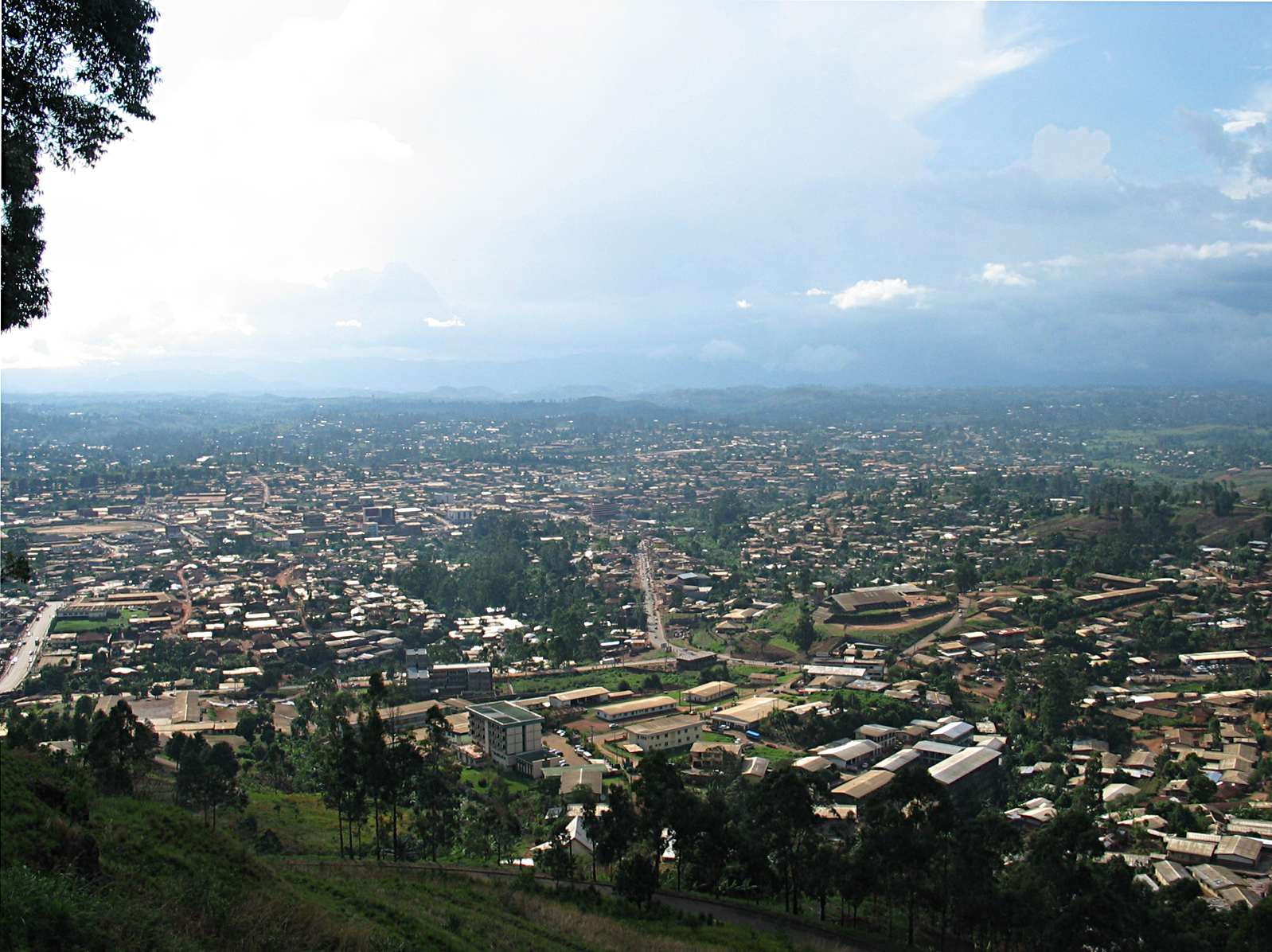- Bamenda
Infobox City |official_name = Bamenda

nickname= Abakwa, which of date is made of two tribes Mankon and Nkwen
image_caption = Bamenda from the mountain road into town
image_
pushpin_
mapsize = 150px
map_caption = Map of Cameroon showing the location of Bamenda
subdivision_type = Province
subdivision_name = Northwest
subdivision_type1 = Division
subdivision_name1 =
subdivision_type2 = Sub-division
subdivision_name2 =
leader_title = Mayor
leader_name =
area_magnitude =
area_total =
area_land =
area_water =
population_as_of = ?
population_urban = 446,000
population_note = estimated
population_total =
population_metro =
area_metro =
population_density =
timezone = WAT
utc_offset = +1
timezone_DST =
utc_offset_DST =
latd=5|latm=56|lats=|latNS=N
longd=10|longm=10|longs=|longEW=E
latitude =
longitude =
website =
footnotes =Bamenda, also known as Abakwa and Mankon Town, is a city in northwestern
Cameroon and capital of the North West Province. The city has an estimated 446,000 inhabitants and is located 366 km (227 mi) north-west of the Cameroonian capital,Yaoundé . Bamenda is known for its cool climate and scenic hilly location.As a provincial centre the city has numerous markets, banks, and offices. The main industries are the processing of agricultural produce such as coffee. The local museum and shops display a wide variety of local baskets, beads, woodcarvings and bronze statues.
In Bamenda there are cultural sites such as the Mankon Fon's Palace with its newly constructed [http://www.museumcam.org/en/mankon/index.php museum] , and the Bali Fon's palace with its ancient architectural structures. The mountainous terrain around the city affords scenic views such as that from the mountain "Sabga" over the "Ndop" plain.
Bamenda is the seat of the largest opposition political party in Cameroon, the
Social Democratic Front (SDF), and the home of its leader,John Fru Ndi . The SDF is Cameroon's largest opposition party and was founded in Bamenda.On
May 26 ,1990 , a group of Bamenda elites launched the party in Ntarikon Bamenda, despite a heavy police presence. However, the launching did not end without casualty. Six civilians were killed.Bamenda is also the birth place of The Southern Cameroons National Council (SCNC), a group that has been asking for the restoration of the former British Southern Cameroons, a territory that covers the English-speaking provinces of North West and South West.
The SCNC was born in Bamenda in 1994, after the All Anglophone Conference (AAC2) issued the Bamenda "Declaration" in which it had asked the government of President
Paul Biya to respond to all Anglophone grievances stated in the Buea Declaration of 1993 or face the wrath of the people of the Southern Cameroons.The Cameroon government failed to respond to the Bamenda Declaration and since then, the SCNC has categorically maintained that it now considers the restoration of the independence of the Southern Cameroons to be final and irrevocable.The city of Bamenda has road links to
Yaoundé andDouala , and an airport, but no scheduled services. To the north of the city is the "Bamenda Ring Road", a 367 km (228 mi) circular route through some of Cameroon's most spectacular mountains. Along this road isMount Oku (3,000 m/9,800 ft), theKimbi River Game Reserve , theMenchum River waterfalls , a huge chief's palace at Bafut, and a pyramidal thatched shrine atAkum (also known as Bagangu).History
In origin the city is an amalgamation of three villages - "Mankon, Mendakwe" and "Nkwen". The first was named for the
Mankon people , and alliance of five ethnic groups which founded a chieftaincy (a "fon") known as the Mankon Fon.Bamenda's principal
ethnic group is theTikar . In the past, the Tikar faced invasions from peoples in the surrounding hills, and between 1700 and 1800, they joined a confederation established by theMbum for defense purposes.Bamenda was subjected to German
colonialism in the late 19th century, and evidence of Germany's former occupation of Bamenda can still be seen today in structures such as the Fort at the Bamenda station. After the defeat of the Germans inWorld War I (1914-1918) theLeague of Nations shared German colonial territories among victorious nations. Western Cameroon was administered jointly withNigeria under the protectorate of the British until 1961 when following a plebiscite it attained independence by joining then the already independent "République du Cameroun".Today, many of the city's inhabitants are English-speaking, and
Cameroonian Pidgin English is the main language spoken in the shops and on the streets of Bamenda. Some Anglophone political pressure groups represented in the city such as theSouthern Cameroons National Council (SCNC) advocatesecession from the rest of Cameroon, which is Francophone.In 1986 the province was the site of disaster when a
limnic eruption ofcarbon dioxide andhydrogen sulfide caused 2,000 deaths atLake Nyos .
Wikimedia Foundation. 2010.

